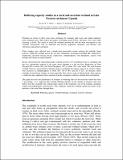Buffering capacity studies in a rural and an urban wetland in Lake Victoria catchment, Uganda
Author
Date
2006Type
Articleviews
downloads
Metadata
Show full item recordxmlui.dri2xhtml.METS-1.0.item-citation
Buffering capacity studies in a rural and an urban wetland in Lake Victoria catchment, Uganda
Abstract/
Wetlands are known to filter water from catchments by retaining solid waste and eroded sediments from catchment areas. They reduce the impact of flooding, speed of flow, and hence store water while releasing it slowly. The extent to which the wetlands perform this role has been investigated in two wetlands, Kinawataka with an industrial and heavily populated catchment, and Kisoma with subsistence agricultural catchment. Water samples were collected once a month from measurable streams entering the wetlands, along transects within the wetland and at the out flow. Parameters investigated included pH, conductivity, temperature, dissolved oxygen, electric conductivity, orthophosphates, total phosphorus, nitrates, total nitrogen and chemical oxygen demand. Results showed that the urban Kinawataka wetland received a lot of pollution from its catchment and this was considerably reduced as the water moves through it to the out flow. Reductions of Total Nitrogen(TN) to about 50% and Total Phosphorus (TP) to about 10% were noted. The rural Kisoma wetland, however, received fewer nutrients from its catchment but releases more in its out flow. There were increases in orthophosphates to about 50%, TP to 40% and TN to 22%. In situations where wetlands received large volumes of water especially after a heavy storm or during floods, their capacity to buffer becomes impaired; hence materials from the catchment would pass through them un-buffered. This paper discusses the performance of wetlands as buffering units for the reservoirs where the water is proceeding. It is suggested that wetland buffering depends on the amount of nutrients and water inflow from the catchment, the wetland-slope, nature of the vegetation, size of the wetland, catchment rainfall and anthropogenic characteristics. The conditions within the wetlands modify the nature of the nutrients as the water flows through them.

